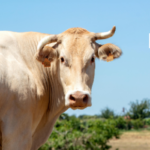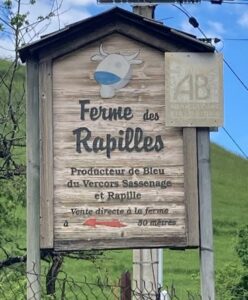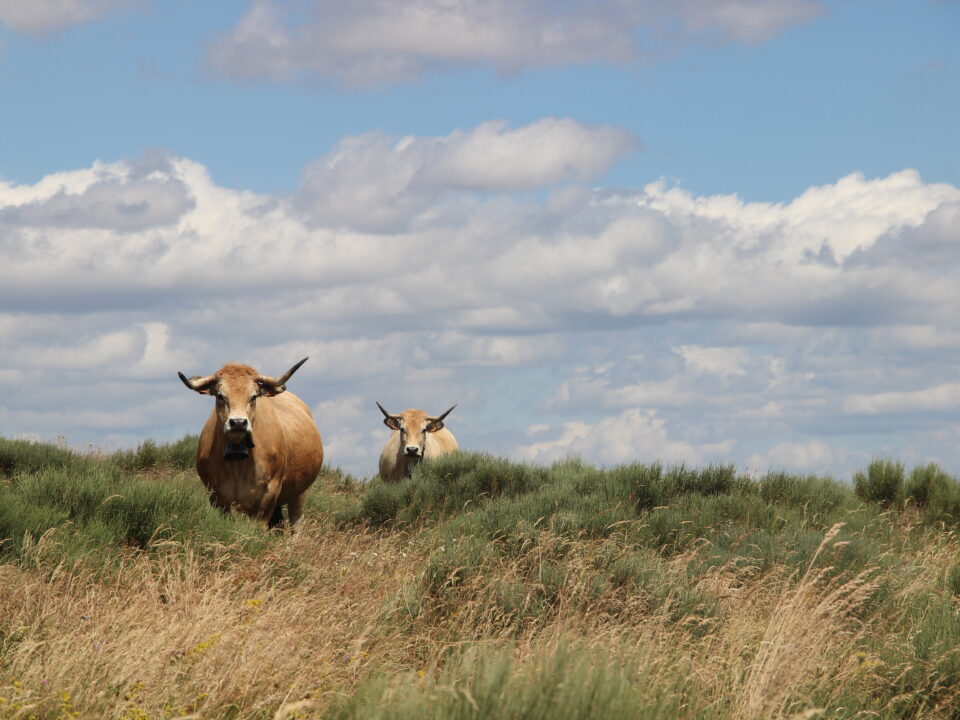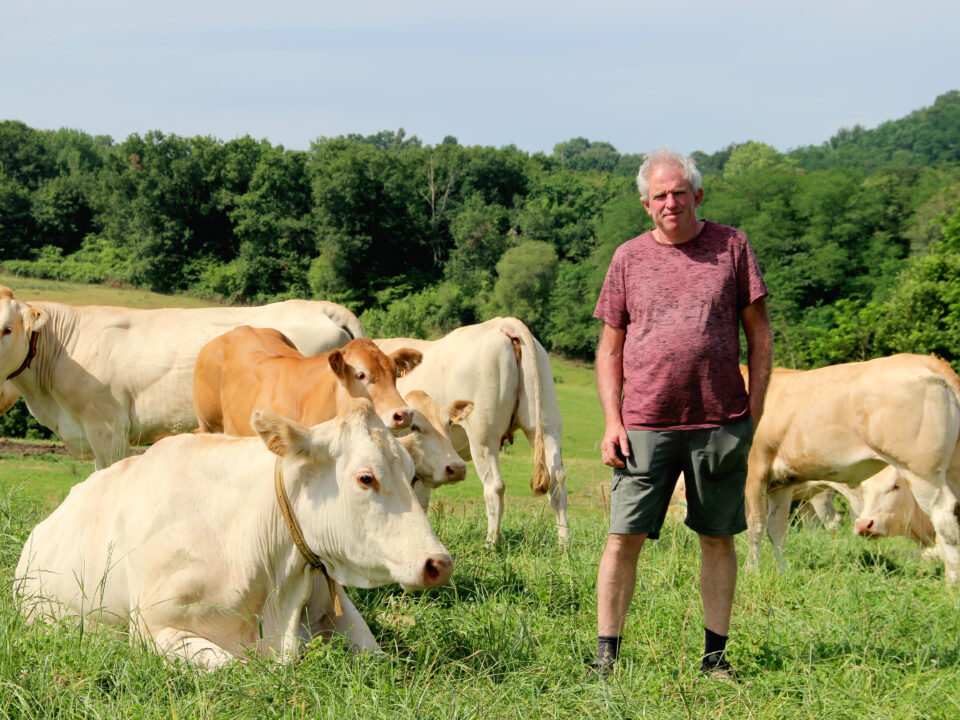
Tarine finds its place in the Pyrenees!
17 June 2024
Auction of Blonde d’Aquitaine cows and heifers
3 July 2024Meeting with GAEC DES RAPILLES (Engins 38) A major player in AURIVA genetics
GAEC DES RAPILLES is based in Engins in the Isère department. Situated at an altitude of 900m, it is now run by Philippe MOINIER and Alain FRANCOZ. Meeting with Josselin FRANCOZ, employee on the farm and future owner of the business
A family history that goes back decades
“The farm has been in existence for several generations. My grandfather owned a few Villard de Lans and then Montbéliarde cows. My father Alain set up in business in the 90s and quickly switched the herd to Abondance. The 1st full Abondance heifers were bought from the GAEC DES GENTIANES (38) then my father quickly crossed the Montbéliardes with Abondance bulls to have only Abondances since 2015. We also have 3 Villard de Lans cows, which is the local breed here in the Vercors.
The reason for the change of breed was that the farm was getting bigger and bigger, and cows were needed that could walk long distances to graze, and that were able to cope with the steep hillsides that are so common in our area.
The current building and barn drying facility were built in 1993. It could accommodate 25 tethered dairy cows. In 1999, Philippe MOINIER joined my father on the farm, setting up outside the family framework.

In 2000, they built the cheese dairy adjacent to the cowshed, as well as maturing cellars and a direct sales outlet.
Over the years, they gradually increased the size of the herd, which now numbers 38 dairy cows. The cheese dairy enables them to transform ¾ of their production into AOP Bleu du Vercors, tomme, lactic cheeses, yoghurts, etc….
The UAA covers 80 hectares, divided into 97% grassland and 3% triticale cereals. Cows graze from mid-April to mid-November.
Today, I’m an employee of the farm and I’m setting up on 01 January 2025 to replace my father, who’s retiring, and Philippe, who’s leaving the GAEC.”
Specifications to be respected in the Bleu du Vercors PDO zone
“We produce 190,000 liters of milk a year and process around 125,000 liters on the farm. The remainder (65,000L) is delivered to the Vercors Lait cooperative in Villars de Lans.
We only deliver to the cooperative at weekends, which means we don’t have to be on call all the time.
As far as the specifications are concerned, they impose few constraints on us and our system: a minimum of 150 days grazing per year, 3% Villard de Lans in the dairy herd, a ban on silage in the ration, and all forage purchased must come from the PDO zone.
On the cheese-making side, our products are sold mainly directly from the farm, but also in producers’ stores and supermarkets in and around Grenoble.
We manage to sell our milk at €1.55/L for processing only. Milk delivered to the cooperative is paid at €600 per tonne.
Abondance, a breed ideally suited to PDO production
“The Abondance breed has been present in the Vercors massif for a very long time. It is appreciated for its hardiness, its ability to travel on stony paths and to make the most of slopes. What’s more, these cows get the most out of their rations, whatever the climate.
Today, average milk recording is 6,000 liters/cow at 34 TP and 37 TB.
We’re happy with this breed because it’s easy to breed and adds value to our system.

"We have been genotyping all our females since the very beginning of the service. We believe in genomics! Genotyping enables us to sort our females for renewal, but also to help us choose the 1st AI. It's important for us to add value to the calves from our heifers. Today, mating planning is carried out alternately by the XR REPRO cooperative and by AURIVA (or OS RAR). Our selection objectives are: TB, milk and morphology. Every year, we put out around 15 purebred doses, 4 of which are sexed, mainly for our replacement heifers. The remainder of the cows are inseminated with YPERIOS Excellence, as this enables the calves to be put to good use. On the purebred side, we use all the bulls in the AURIVA catalog. On our latest batch of heifers, 80% of the females are daughters of young bulls!
Josselin FRANCOZ
A major player in AURIVA genetics
“We have 4 home-grown bulls that have joined the Brindas seed production center.
- NOX son of BUNNY / CACAHUETE was born on 15/06/2017. He was selected by AURIVA following his genotyping results, as his dam was a targeted bull dam. CACAHUETE is a LAMBORGHINI/VENISE daughter, born on the farm in 2007. Her dam VENISE was also born on the farm in 2004. This strain comes from the GAEC DES GENTIANES and is still present on the farm today. Today, the bull reflects the lineage: good in breeding (+0.3 in STMA) and body (111), well average in milk NOX had been distributed as a young sire in 2019/2020 and was present in the conformation and functional segments.
- SORNIN distributed as a young sire in 2022/2023, son of NELUMBO/MARJOLAINE, was born on 23/03/2021. MARJOLAINE is a daughter of IKEA/HERMINE. His great-grandmother (TIGRA) had been bought in Haute-Savoie by my father. Her dam BELLE-ISLE was born on the farm in 2006. This is a rather dairy strain, but average in body and function. MARJOLAINE was collected as an embryo transplant from GAEC LES ABONDANCES (74). She had donated 3 embryos, including the bull PAGA, also selected by AURIVA. SORNIN was present in the udder segment.
- TRACOLET will be added to the AURIVA catalog in July 2024. He is also a son of MARJOLAINE on NOX born on 28/05/2022. 100% on-farm breeding! He is the3rd MARJOLAINE son to join the AURIVA station, after PAGA and SORNIN. TRACOLET will be present in the conformation segment.
- URION son of RADIAN / REGLISSE was born on 12/12/2023. He has just joined the Brindas breeding station. It’s a variable strain, notably because its mother REGLISSE is a daughter of HEUREUX/JOCONDE. JOCONDE is a great-granddaughter of TIGRA.
It’s a source of pride for us to be able to contribute to the AURIVA selection scheme, and the reward for many years of genetic work!
And tomorrow?
“For my part, I’m on my way to taking over the farm on January 01, 2025, to replace my father and Philippe who will soon be leaving the GAEC. Ideally, I’d like to find a partner, and an online advert will be circulated via the Isère Chamber of Agriculture. Otherwise, I’d turn to salaried workers, as we need at least 2, if not 2.5, labour units on the farm.
Finally, I’d like to develop the Villard de Lans breed by increasing the size of the herd.
If you’re ever interested in settling in the Vercors massif, or know someone who might be, I’d love to hear from you! Don’t hesitate to contact us!




